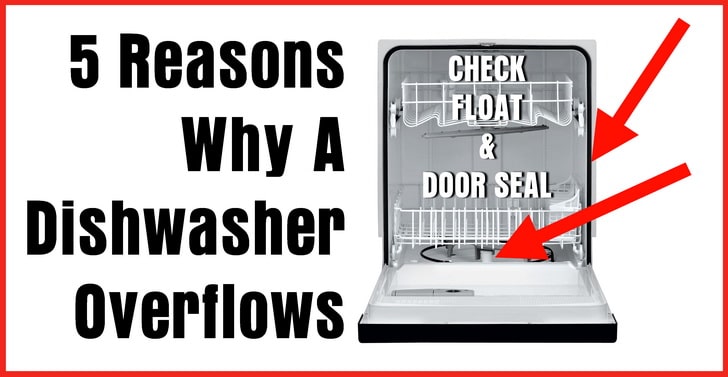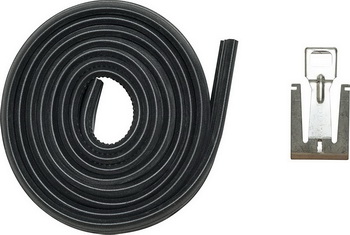Dishwasher has water overflow issues. Water overflows from your dishwasher and leaks a puddle of water on the floor. When this happens it needs to be fixed ASAP as flooding can cause heavy damage. The dishwasher needs to be checked for what is causing the water overflow. We will explain the reasons why the dishwasher is overflowing and how to fix it.
Dishwasher Overflows Water – How To Fix?
CHECK FLOAT, DOOR SEAL, EXCESS DETERGENT
Troubleshoot why a dishwasher can overflow. The 5 reasons listed are the most likely problems that can cause a dishwasher to overflow. If you do not find the problem after trying everything on this page, please leave us a comment below and let us know your exact dishwasher issue and we can assist. Please remember to unplug power before troubleshooting.
5 Reasons Why Dishwasher Overflows:
1. Float Assembly Is Stuck Or Faulty
2. Too Much Soap Creates Excessive Suds
3. Dishwasher Door Gasket Fault
4. Water Inlet Valve Malfunction
5. Bottom Of Dishwasher Clogged/Blocked
Float Assembly Is Stuck Or Faulty
When water enters the dishwasher, the float assembly moves upward and tells the dishwasher water valve when to shut the water off. If the float is stuck in the UP position, the dishwasher may overfill. Check the float assembly to find out if the float may be stuck. There is also a switch connected to the float that can fail so check both. The float switch is located on the inside bottom of the dishwasher.
 Dishwasher Float Valve Assembly
Dishwasher Float Valve Assembly
IS FLOAT STUCK IN UP POSITION?
Too Much Soap Creates Excessive Suds
If the overflowing water has excessive soap suds, the issue is with the detergent itself. Using too much detergent can create more soapy suds than the dishwasher can handle. When a large amount of soap is used, the soap suds expand so much that the soap comes through the dishwasher door and overflows onto the floor. Using a dollar store dishwashing detergent can also cause this issue as cheap soap can create excessive suds. Use less soap or switch your dishwasher detergent.
Dishwasher Door Gasket Fault
If water or soap suds escape past the dishwasher door and onto the floor, the sealing gasket on the dishwasher door is most likely worn out and needs to be replaced. When the dishwasher door is closed, the rubber seal going around the entire interior door is what seals the water inside. If this gasket gets ripped, brittle, or worn out, water will overflow onto the floor. You can attempt to clean the gasket and add a small amount of petroleum jelly to see if that stops the leak. If you find the dishwasher door gasket to be in bad condition you should replace it ASAP.
Dishwasher Door Gasket
DAMAGED OR DIRTY SEAL? CLEAN AND RETRY
Water Inlet Valve Malfunction
The dishwasher is supplied with water from the water inlet valve. This valve can malfunction and fill the dishwasher with water when not in use. If you see water in the dishwasher when you are not using it, check the water inlet valve for faults. If this valve is faulty, the dishwasher can fill with water and overflow onto the floor. If any fault is found with the valve, it needs to be replaced. The water inlet valve is usually located under the dishwasher and connected to the water line coming from under the sink.
Dishwasher Water Inlet Valve
FAULTY VALVE CAN CAUSE OVERFLOW
Bottom Of Dishwasher Clogged/Blocked
The bottom of the dishwasher can become filled with food particles. These particles can clog up the area where the water drains out. If the water cannot drain out of the dishwasher, water eventually flows upward and will leak out of the door and overflow. To avoid blockages, always clear the bottom of the dishwasher out after use. Keep the filter clean and always check for any broken glasses or plates from blocking the bottom of the dishwasher. Keeping a clean dishwasher can help it to run as designed.
Other issues that can cause dishwasher water overflow…
Broken wash arm – Pushes water under door and leaks.
Cracked motor shaft seal – Water gets through a bad seal.
Damaged sump seal – Water can leak if gasket is bad.
Common Reasons A Dishwasher Leaks/Overflows
All dishwasher overflow troubleshooting methods above will work on GE, Maytag, Sharp, Bosch, KitchenAid, Whirlpool, Samsung, LG, Haier, Kenmore, Hotpoint, Emerson and Frigidaire dishwashers as all dishwashers have the same basic components.
 Common Dishwasher Replacement Parts
Common Dishwasher Replacement Parts
Do you need help with a dishwasher overflowing or leaking? Contact us below and please describe your issue and leave the dishwasher model number for us to help you to solve the overflowing problem.
Need help finding the dishwasher model number? Find the dishwashers model number






Richard Bruell,
If the water is coming into the dishwasher at a normal flow rate, be sure to check the float switch, as if it is stuck in the up position, the dishwasher can leak.
-RR
i have a essentials dish washer CID60W20 it is overflowing through the side rails in to the flood tray at the bottom and shutting down. i have googled regarding the pressure sensor or water level sensor and cant find anything for this model. it seems as if it is over filling slightly.
Kenmore model # 665.13693N411,leaking @ left bottom corner of door.
PROBLEM FIXED. TURNED OUT NOT BE AN OVERFLOW PROBLEM.
I’ve investigated my overflow problem more. Took the float out again and it did have very small amount of crud that I cleaned out of it. Put it back together, then turned on the dishwasher again. It seemed like the dishwasher did not fill quite as full. May have helped a little.
I wanted to make sure the water level switch that was activated by the float was working. So, I restarted the dishwasher and manually pressed the button on the switch to shut off the water as it was initially filling. It did stop the water.
The dishwasher continued to leak across the front door seal. Another person commented to check the lower spray arm for cracks. So, I removed the lower spray arm, stuck a cut-off water hose into the water inlet hole and turned on the water. Sure enough, water sprayed out of a slit in the side where the top and bottom halves of the spray arm came together. Another commenter stated this would cause water to spray under the lower door seal.
I have ordered a new lower spray arm. Hopefully this will fix my problem. May not have been an overflow problem at all. I will update when my part comes in.
UPDATE: New Lower spray arm fixed the problem. No more leaking. Although no cracks could be visibly seen, it did spray out water using the water hose test stated above. This must have sprayed the water just right to go under the lower door seal.
Charles Miller,
Any type of fault code or beeping heard during the time of the problem?
Is the dishwasher level?
Be sure it is not at a slight angle as this can cause an overfill issue.
Is an object stuck on the float and allowing water to keep filling?
A foreign object such as food or broken glass can prevent the float from moving and cause an overfill issue.
If you tested the float and heard a click but it did not shut the water off, there could be an issue with the float valve or possibly a wiring fault.
-RR
I have a Kenmore model 665.14529N611 dishwasher that is leaking across the bottom front of the door. I’ve replaced the bottom door seal, the inside seal around the door, then disassembled the float and checked it. Next, I checked the water level sensor the float activates with a multimeter. The float moves as it should and makes the sensor click, but it seems like the water keeps filling and shuts off just a little too late and the machine gets too full so that water still drips our from along the front door bottom seal. (I used a mirror to look under the unit while it was running to be sure where the water was coming from – across the bottom seal). I’ve opened the door just after the initial fill of water when the unit is turned on, and it seems to be too full of water, pushing the float higher than it needs to be to activate the sensor. As it was filling, I heard clicks that maybe should have shut the water off, but did not. The overflow problem seemed to have just started all of a sudden; was working fine. What could allow the unit to overfill if the float and water level sensor are working properly?
I’m having exactly the same problem, WDT950SAHZ, did you find the problem?
On many new high end dishwasher, the is only an overflow sensor and no overfill float sensor. The software doesn’t account for water pressure variations.
I have a Frigidaire Dishwasher model #FGBD2434PF3A, that intermittently leaks from the bottom of the Overfill Protector of dishwasher while running. It does appear to move up and down properly. Do you have any suggestions to fix this problem please?
Sounds almost exactly my issue. Whirlpool, different model. But the door seal and float have already been replaced and it’s still flooding the floor, only when I’m trying to run a cycle. 3 yrs old.
I have a whirlpool WDT720PADM2 dishwasher and am having an overflow problem. It’s only a couple of years old so the door seal looks to be in good shape. I checked the float switch with a multimeter and it’s functioning as it should. It’s only overflowing while it’s in operation so I’m assuming I can rule out the water inlet valve as well. The filter inside is clean and there’s no debris in there. The machine was working flawless until the pump/motor assembly failed and I replaced it. This is my second time replacing that part so I’m pretty sure I didn’t do it incorrectly but that’s the only thing I’ve done with the dishwasher prior to having the overflow issue. I’d rather not have to go out and buy a new one so I’d really appreciate any help you may be able to give. I can also rule out the access soap because I use one pod just like I’ve been doing for the past 2-3 years. Please help